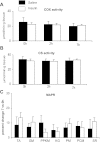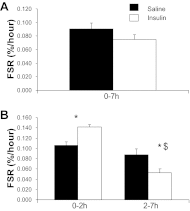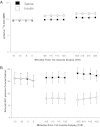Insulin fails to enhance mTOR phosphorylation, mitochondrial protein synthesis, and ATP production in human skeletal muscle without amino acid replacement
- PMID: 22967500
- PMCID: PMC3492854
- DOI: 10.1152/ajpendo.00067.2012
Insulin fails to enhance mTOR phosphorylation, mitochondrial protein synthesis, and ATP production in human skeletal muscle without amino acid replacement
Abstract
Systemic insulin administration causes hypoaminoacidemia by inhibiting protein degradation, which may in turn inhibit muscle protein synthesis (PS). Insulin enhances muscle mitochondrial PS and ATP production when hypoaminoacidemia is prevented by exogenous amino acid (AA) replacement. We determined whether insulin would stimulate mitochondrial PS and ATP production in the absence of AA replacement. Using l-[1,2-¹³C]leucine as a tracer, we measured the fractional synthetic rate of mitochondrial as well as sarcoplasmic and mixed muscle proteins in 18 participants during sustained (7-h) insulin or saline infusion (n = 9 each). We also measured muscle ATP production, mitochondrial enzyme activities, mRNA levels of mitochondrial genes, and phosphorylation of signaling proteins regulating protein synthesis. The concentration of circulating essential AA decreased during insulin infusion. Mitochondrial, sarcoplasmic, and mixed muscle PS rates were also lower during insulin (2-7 h) than during saline infusions despite increased mRNA levels of selected mitochondrial genes. Under these conditions, insulin did not alter mitochondrial enzyme activities and ATP production. These effects were associated with enhanced phosphorylation of Akt but not of protein synthesis activators mTOR, p70(S6K), and 4EBP1. In conclusion, sustained physiological hyperinsulinemia without AA replacement did not stimulate PS of mixed muscle or protein subfractions and did not alter muscle mitochondrial ATP production in healthy humans. These results support that insulin and AA act in conjunction to stimulate muscle mitochondrial function and mitochondrial protein synthesis.
Figures







Similar articles
-
An amino acid mixture enhances insulin-stimulated glucose uptake in isolated rat epitrochlearis muscle.J Appl Physiol (1985). 2011 Jul;111(1):163-9. doi: 10.1152/japplphysiol.01368.2010. Epub 2011 Apr 28. J Appl Physiol (1985). 2011. PMID: 21527668
-
Insulin is required for amino acid stimulation of dual pathways for translational control in skeletal muscle in the late-gestation ovine fetus.Am J Physiol Endocrinol Metab. 2009 Jan;296(1):E56-63. doi: 10.1152/ajpendo.90310.2008. Epub 2008 Oct 21. Am J Physiol Endocrinol Metab. 2009. PMID: 18940943 Free PMC article.
-
Amino acids stimulate translation initiation and protein synthesis through an Akt-independent pathway in human skeletal muscle.J Clin Endocrinol Metab. 2002 Dec;87(12):5553-8. doi: 10.1210/jc.2002-020424. J Clin Endocrinol Metab. 2002. PMID: 12466352
-
Insulin regulation of mitochondrial proteins and oxidative phosphorylation in human muscle.Trends Endocrinol Metab. 2003 Nov;14(9):393-4. doi: 10.1016/j.tem.2003.09.002. Trends Endocrinol Metab. 2003. PMID: 14580754 Review.
-
Mitochondrial metabolic function assessed in vivo and in vitro.Curr Opin Clin Nutr Metab Care. 2010 Sep;13(5):511-7. doi: 10.1097/MCO.0b013e32833cc93d. Curr Opin Clin Nutr Metab Care. 2010. PMID: 20616711 Free PMC article. Review.
Cited by
-
Risk of hypertension following perinatal adversity: IUGR and prematurity.J Endocrinol. 2019 Jul 1;242(1):T21-T32. doi: 10.1530/JOE-18-0687. J Endocrinol. 2019. PMID: 30657741 Free PMC article. Review.
-
Combined Effects of Citrulline Plus Nitrate-Rich Beetroot Extract Co-Supplementation on Maximal and Endurance-Strength and Aerobic Power in Trained Male Triathletes: A Randomized Double-Blind, Placebo-Controlled Trial.Nutrients. 2021 Dec 23;14(1):40. doi: 10.3390/nu14010040. Nutrients. 2021. PMID: 35010917 Free PMC article. Clinical Trial.
-
Markers of autophagy are adapted to hyperglycaemia in skeletal muscle in type 2 diabetes.Diabetologia. 2015 Sep;58(9):2087-95. doi: 10.1007/s00125-015-3654-0. Epub 2015 Jun 7. Diabetologia. 2015. PMID: 26048236
-
l-Citrulline Supplementation: Impact on Cardiometabolic Health.Nutrients. 2018 Jul 19;10(7):921. doi: 10.3390/nu10070921. Nutrients. 2018. PMID: 30029482 Free PMC article. Review.
-
Regulation of autophagy by amino acids and MTOR-dependent signal transduction.Amino Acids. 2015 Oct;47(10):2037-63. doi: 10.1007/s00726-014-1765-4. Epub 2014 Jun 1. Amino Acids. 2015. PMID: 24880909 Free PMC article. Review.
References
-
- Asmann YW, Stump CS, Short KR, Coenen-Schimke JM, Guo Z, Bigelow M, Nair KS. Skeletal muscle mitochondrial functions, mitochondrial DNA copy numbers, and gene transcript profiles in type 2 diabetic and nondiabetic subjects at equal levels of low or high insulin and euglycemia. Diabetes 55: 3309–3319, 2006 - PubMed
-
- Balagopal P, Ford GC, Ebenstein DB, Nadeau DA, Nair KS. Mass spectrometric methods for determination of [13C]leucine enrichment in human muscle protein. Anal Biochem 239: 77–85, 1996 - PubMed
-
- Chow LS, Albright RC, Bigelow ML, Toffolo G, Cobelli C, Nair KS. Mechanism of insulin's anabolic effect on muscle: measurements of muscle protein synthesis and breakdown using aminoacyl-tRNA and other surrogate measures. Am J Physiol Endocrinol Metab 291: E729–E736, 2006 - PubMed
-
- Cunningham JT, Rodgers JT, Arlow DH, Vazquez F, Mootha VK, Puigserver P. mTOR controls mitochondrial oxidative function through a YY1-PGC-1[agr] transcriptional complex. Nature 450: 736–740, 2007 - PubMed
Publication types
MeSH terms
Substances
Grants and funding
LinkOut - more resources
Full Text Sources
Medical
Miscellaneous

